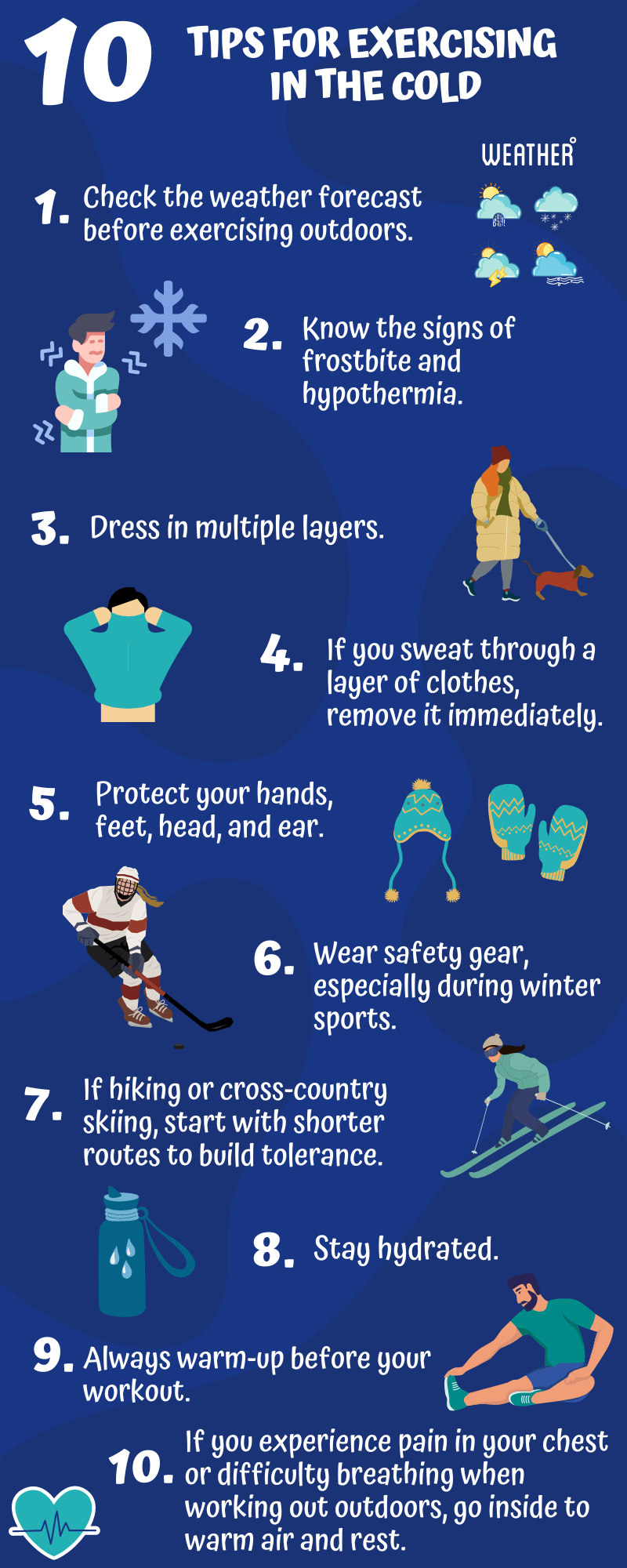10 Tips for Exercising in the Cold [Infographic]
Exercising outdoors, even in winter, can be very beneficial. Exercising in the cold can actually help you burn more calories, enhance your endurance, positively affect your metabolism, and improve your mental health. However, it is important to take precautions when exercising outdoors in the cold to stay safe.
Check the weather forecast before exercising outdoors. When planning a safe workout in cold weather, it’s essential to check the weather forecast for temperature, wind chill, and moisture in the area. These factors can influence whether or not it is safe to exercise outdoors, e.g. wind chill can penetrate your clothing and remove the insulation of warm air. If the temperature is below 0 °F or the wind chill is extreme, exercise indoors. If it is raining, snowing, or icy, wear waterproof gear and shoes with good traction.
Know the signs of frostbite and hypothermia. Frostbite can happen to exposed skin like the cheeks, nose, ears, hands, and feet when exposed to extreme cold for a prolonged period. Frostbite symptoms can include numbness, loss of feeling, or a stinging sensation. If you suspect frostbite, get out of the cold immediately and slowly warm the affected area with warm water. Hypothermia can result from abnormally low body temperature. When exposed to extremely cold temperatures, your body can lose heat faster than it can be produced which can lead to intense shivering, slurred speech, loss of coordination, and fatigue.
Dress in multiple layers. It’s critical to dress in multiple layers and wear synthetic fibers like polyester, nylon, and polypropylene which are designed to dry quickly. These fabrics wick away moisture 50% faster than cotton. Dressing in layers allows you to remove layers as you sweat and put them back on as needed. Avoid wearing cotton as it stays wet from the sweat next to your skin. On top, wear a layer that is breathable and waterproof.
If you sweat through a layer of clothes, remove it immediately. Exercise generates a significant amount of heat, enough to make you feel it’s much warmer than it is. If you do sweat through a layer of your clothes, remove it immediately because wearing damp clothing in windy or cold weather can make you more susceptible to hypothermia.
Protect your hands, feet, head, and ears. Blood flow is concentrated in your body’s core when exercising outdoors, which leaves extremities like your hands, head, and feet more vulnerable to cold and frostbite. Wear a thin pair of glove liners made of a wicking material under a pair of heavier gloves or mittens that are lined with wool or fleece. Wear thermal socks or an extra pair of regular socks and wear a scarf around your neck. Wearing a wool hat is important as more than 50% of your body heat exits from your head.
Wear safety gear, especially during winter sports. During winter, many engage in winter sports like skiing, snowboarding, and snowmobiling. It’s important to wear protective gear, such as helmets and goggles. If exercising outdoors during dusk or dawn, wear reflective clothing. Place portable heat packs to warm up your hands and feet.
If hiking or cross-country skiing, start with shorter routes to build tolerance. It’s important to build up tolerance, endurance, and stamina through shorter routes when engaging in outdoor activities like hiking or cross-country skiing in the winter. Wear the right footwear, such as waterproof hiking boots.
Stay hydrated. Be sure to hydrate before, during, and after working out outside. Due to the sweating, breathing, and drying power of the wind, you can become dehydrated exercising outdoors without realizing it.
Always warm up before your workout. It’s essential to warm up your body before exercising outdoors through stretching and dynamic movements. The purpose of warming up is to increase your internal body temperature in preparation for your workout by improving blood flow to your limbs and increasing muscle activation. An effective, dynamic warm-up should move your major joints through their optimal range of motion and work your muscles in specific movement patterns to warm them up.
If you experience pain in your chest or difficulty breathing when working out outdoors, go inside to warm air and rest. Cold weather can increase the likelihood of a cardiac-related or asthma-induced event due to breathing in cold air, which can restrict blood vessels. If you do experience any pain in your chest or issues breathing during an outdoor workout, go inside and rest and seek medical care.
Don’t let cold weather stop you from exercising outdoors! Keep these 10 tips in mind when exercising outdoors in the cold!
